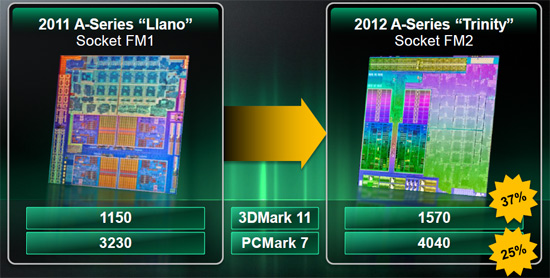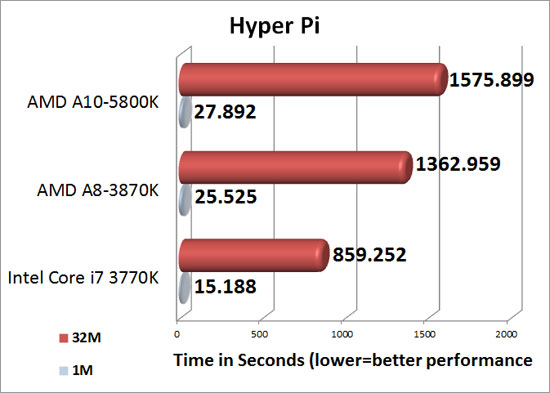AMD A10-5800K Trinity Desktop APU Review
Final Thoughts and Conclusion

The AMD A10-5800K is the flagship for the 2012 AMD A-Series APU’s. That doesn’t mean that it is the king of the hill in all things computer related. Quite the opposite in fact. In the majority of our x86 benchmarks, the A10-5800K wasn’t much faster, if at all than the previous generation A8-3870K. The prowess of the AMD A10-5800K doesn’t rear it’s head until we start testing the graphics capabilities of the second generation APU. The AMD A10-5800K takes advantage of the AMD Radeon HD 7660D, which considering the fact that it’s onboard the APU, turned out to be a very capable graphics card.
The internal testing from AMD that we can see above shows a 37% increase in the 3DMark 11 score between the first generation A-Series Llano and this generation of A-Series Trinity. While our numbers don’t match their numbers exactly, our Llano system scored 1115 3Dmarks while the AMD internal testing showed 1150 3DMarks. Our AMD A10-5800K scored 1521 3DMarks while they scored 1570. The overall difference was remarkably similar, AMD is boasting an increase of 37% and we saw a difference of 36.4%!
You probably noticed that the AMD AMD A8-3870K Llano system was running faster in several of the multi-threaded tests than the new Trinity A10-5800K was, you aren’t the only ones. Considering that the AMD A10-5800K has a base clock of 3.8GHz and a maximum clock speed of 4.2GHz, and the AMD A8-3870K has a base clock of 3.0GHz we found our results rather peculiar. In order to try and solve this conundrum we reached out to AMD, this is what they had to say.
As far as the results, in some instances, the single-threaded to multi-threaded performance of Trinity will sometimes scale less than Llano due to some resource sharing in the x86 modules. You should find that multi-threaded performance should be close to Llano in the instances where it is not better.

Our testing with Hyper Pi is a prime example of the issue that we are running into. The AMD A8-3870K completed the 32M test in 1362.959 seconds while the AMD A10-5800K took 1575.899 seconds. That’s a difference of 15.6%! From AMD’s explanation above it seems that the x86 resource’s that are shared in the Piledriver modules may be the culprit.
When it comes to overclocking the AMD A10-5800K APU has a little overclocking headroom available, but the bottleneck is the retail boxed CPU cooler. We were able to get it up to 4.4GHz on the stock CPU cooler and that was about all she had room for before the APU started to be throttled. With a larger CPU cooler we were able to get to 4.6GHz with ease. We were able to get some significant performance gains from overclocking, so if you have the desire to overclock an APU then you will be rewarded!
The AMD A10-5800K is in a unique position in the market. The x86 performance wasn’t stellar, but the gaming performance was exceptional considering we weren’t using a discrete graphics card. Ultimately, it’s all going to come down to what you are looking to do with your computer. If you are looking to build a system on a budget to run your daily applications like Microsoft Office, Adobe Photoshop and other common programs I don’t think you can go wrong with a set-up like we were using today. For many of those application you’ll notice a bigger difference with a SSD over a traditional hard drive than you will a faster processor. A SSD will speed up your load time considerably over a HDD and add a whole different level of responsiveness. The suggested retail price of the GIGABYTE GA-F2A85X-UP4 is $139.99, this may be a little on the higher end of the price spectrum for AMD FM2 motherboard but only time will tell. Pair the GIGABYTE GA-F2A85X-UP4 with the AMD A10-5800K and you’re right around the $260 mark, $70 less than the cost of the Intel Core i7 3770K alone. That would be enough to pick up a 16GB kit of memory, or a 120GB-128GB SSD on sale!
Legit Bottom Line: The AMD A10-5800K will easily run your day to day applications without an issue and if you’re looking to do some light gaming you’re golden. The AMD A10-5800K featuring the AMD Radeon HD 7660D you will be able to run the latest DirectX 11 games with some of the eye candy turned on.

Comments are closed.